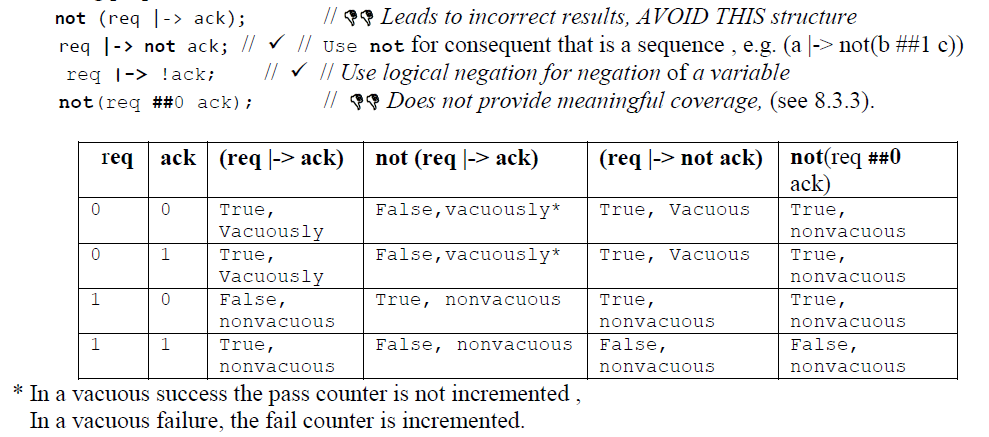What i “not” property operator in System verilog Assertion?
please explain with example.
In reply to Mukund Sojitra:
What is “not” property operator in System verilog Assertion?
please explain with example.
The answer is in 1800.
1800’2012
16.12.2 Negation property
A property is a negation if it has the form not property_expr. For each evaluation attempt of the property, there is an evaluation attempt of property_expr. The keyword not states that the evaluation of the property returns the opposite of the evaluation of the underlying property_expr. Thus, if property_expr evaluates to true, then not property_expr evaluates to false; and if property_expr evaluates to false, then not property_expr evaluates to true.
The not operator switches the strength of a property. In particular, one should be careful when negating a sequence. For example, consider the following assertion:
a1: assert property (@clk not a ##1 b);
Since the sequential property a ##1 b is used in an assertion, it is weak. This means that if clk stops ticking and a holds at the last tick of clk, the weak sequential property a ##1 b will also hold beginning at that tick, and so the assertion a1 will fail. In this case it is more reasonable to use:
a2: assert property (@clk not strong(a ##1 b));
Ben Cohen
http://www.systemverilog.us/ ben@systemverilog.us
For training, consulting, services: contact Home - My cvcblr
- SVA Handbook 4th Edition, 2016 ISBN 978-1518681448
- A Pragmatic Approach to VMM Adoption 2006 ISBN 0-9705394-9-5
- Using PSL/SUGAR for Formal and Dynamic Verification 2nd Edition, 2004, ISBN 0-9705394-6-0
- Real Chip Design and Verification Using Verilog and VHDL, 2002 isbn 978-1539769712
- Component Design by Example ", 2001 ISBN 0-9705394-0-1
- VHDL Coding Styles and Methodologies, 2nd Edition, 1999 ISBN 0-7923-8474-1
- VHDL Answers to Frequently Asked Questions, 2nd Edition ISBN 0-7923-8115
In reply to Mukund Sojitra:
In temporal languages, there are 2 common styles of property description/specification viz:
- Express a property that shall hold
- Express a property that shall NOT/never hold
SVA’s property level not operator falls in #2 style above. In PSL it is called “never” - FWIW.
Consider a req signal that shall be a pulse - meaning it can be high for only one clock (per
access of-course). There are 2 styles to capture this requirement:
Style - 1:
property p_sig_is_pulse (sig);
sig !=> !sig; // Assume default clk, abort etc.
endproperty : p_sig_is_pulse
Style - 2:
property p_sign_shall_never_be_high_cont (sig);
not (sig [*2]; // Assume default clk, abort etc.
endproperty : p_sign_shall_never_be_high_cont
Which one to use - your choice. But I see many engineers using Style-1. And also consider that Style-2 has potential issues with implication operator etc. (As Ben pointed out).
HTH
Srini
www.verifworks.com
Thanks for your kind Help.
In reply to Mukund Sojitra:
From our SVA Handbook 4th Edition
Vacuity
[1] An evaluation attempt of a property of the form not property_expr is nonvacuous if, and only if, the underlying evaluation attempt of property_expr is nonvacuous. Thus, the not(vacuous_property) (e.g., not(a |-> b)) is vacuously false if a==0; this is because (a → b) is vacuously true. Simulators process a vacuous failure as a valid failure, and provide statistical contributions to the fail counter.
Guideline: Limit the use of the not property operator in properties where the property_expr is a sequence, Boolean, or property with until, eventually. Do not use the not operator in properties where the property_expr can be vacuous. The reason for this recommendation is that negated assertions that contain the implication operators are difficult to understand and can be misleading. The following property statement specifications demonstrate the issues. The requirements state that a request should never be followed by an acknowledge in the same cycle, thus if req ==1, ack must be ==0 in the same cycle). The table below demonstrates the difference in results between the following properties:
not (req |-> ack); // Leads to incorrect results, AVOID THIS structure
req |-> not ack; // // Use not for consequent that is a sequence , e.g. (a |-> not(b ##1 c))
req |-> !ack; // // Use logical negation for negation of a variable
not(req ##0 ack); // Does not provide meaningful coverage,
Ben Cohen
http://www.systemverilog.us/ ben@systemverilog.us
For training, consulting, services: contact Home - My cvcblr
- SVA Handbook 4th Edition, 2016 ISBN 978-1518681448
- A Pragmatic Approach to VMM Adoption 2006 ISBN 0-9705394-9-5
- Using PSL/SUGAR for Formal and Dynamic Verification 2nd Edition, 2004, ISBN 0-9705394-6-0
- Real Chip Design and Verification Using Verilog and VHDL, 2002 isbn 978-1539769712
- Component Design by Example ", 2001 ISBN 0-9705394-0-1
- VHDL Coding Styles and Methodologies, 2nd Edition, 1999 ISBN 0-7923-8474-1
- VHDL Answers to Frequently Asked Questions, 2nd Edition ISBN 0-7923-8115
Thank you very Much Ben. You are helping me a lot.
